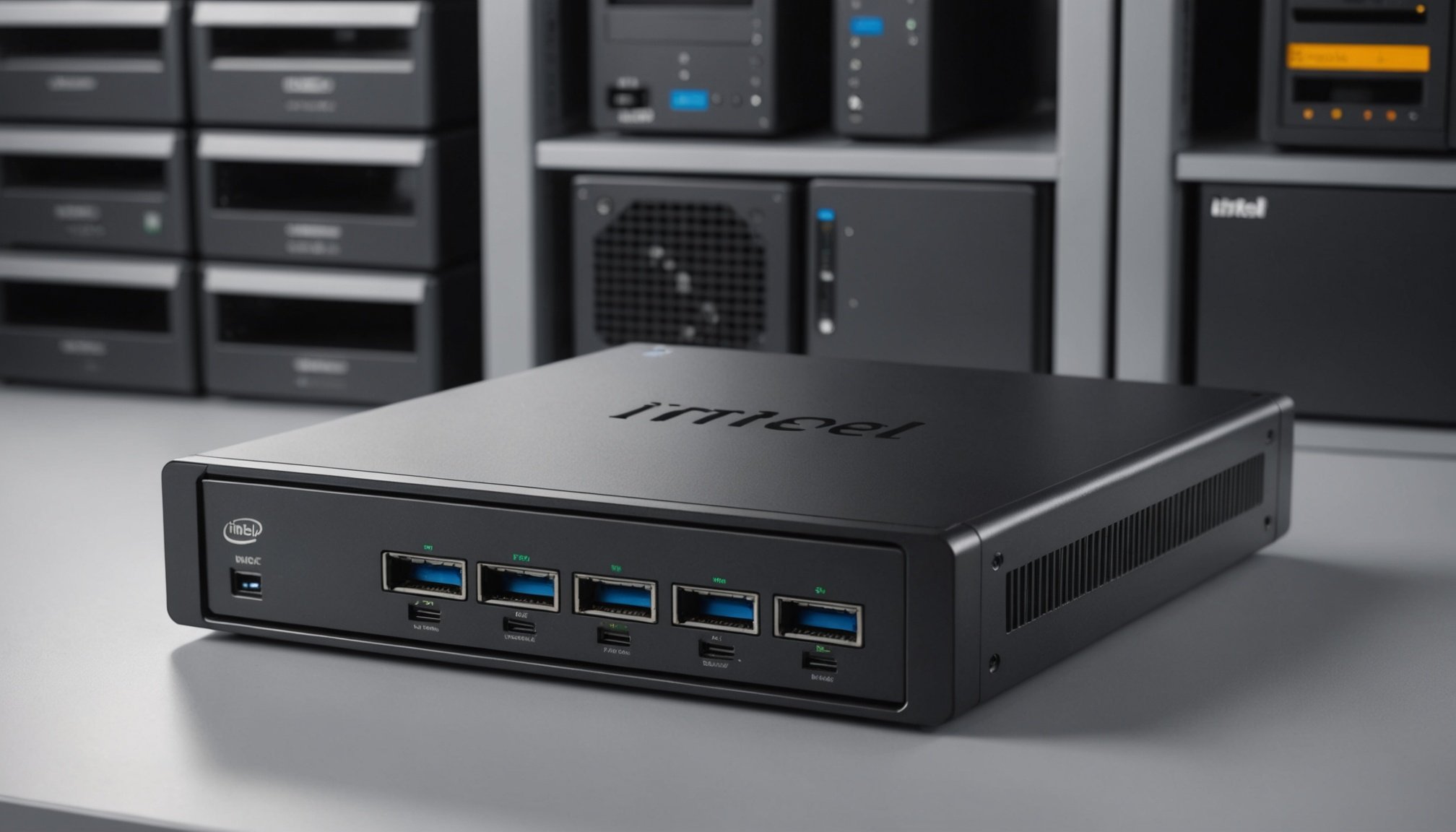Overview of Intel NUC for File Server Use
The Intel NUC is a popular choice for file server applications due to its compact design, energy efficiency, and versatility. When selecting an Intel NUC for this purpose, it is vital to consider the hardware specifications that align with your needs.
Benefits of Intel NUC for File Servers
- Compact Design: The Intel NUC’s small form factor makes it ideal for environments with limited space.
- Energy Efficiency: Consuming less power than traditional servers, it is cost-effective and environmentally friendly.
- Versatility: Compatible with various operating systems, offering flexibility in software choices.
Key Specifications and Models
When selecting an Intel NUC, focus on models that offer:
- High RAM Capacity: Essential for managing multiple file requests simultaneously.
- Robust Processor: Ensures efficient handling of server tasks.
- Ample Storage Options: Models with SSD capabilities provide faster data access and retrieval.
Comparison with Traditional Server Hardware
Intel NUCs differ from traditional servers primarily in size and power consumption. While traditional servers may offer higher performance, they require more space and energy. The NUC’s hardware specifications are typically sufficient for small to medium-scale file serving, making it a practical alternative.
Setting Up Windows Server 2022
Installing Windows Server 2022 on an Intel NUC requires precision and follow-through. Begin with a compatible Intel NUC, ensuring it meets minimum hardware requirements for Windows Server 2022 installation. Use a bootable USB drive to start the installation process. Enter the BIOS setup and configure boot order, prioritizing the USB device.
Proceed with the installation by following on-screen prompts, choosing a custom installation if you want more control over disk partitions. Select appropriate partition settings and complete installation by allowing Windows Server 2022 to restart and finalise setup.
Initial configuration settings are crucial. Start with defining your server’s role, whether it’s an Active Directory domain, DNS server, or another crucial role. Configure network settings, ensuring the server has a static IP address for stability. Setting a strong administrative password and configuring local security policies is essential for protection.
Consider licensing options: Windows Server 2022 offers different levels such as Standard and Datacenter, each with different benefits. Lastly, stay updated by enabling automatic updates to secure your server with the latest patches and security enhancements. Prioritising setup and security will optimise your Windows Server 2022 experience on an Intel NUC.
Security Features in Windows Server 2022
Windows Server 2022 introduces a robust suite of security features aimed at safeguarding enterprise environments. The built-in Windows Server security capabilities offer protection at multiple layers, ensuring that both data and access are meticulously managed.
Built-in Security Features
Among the notable security enhancements is the advancement in file server security, which uses encryption technologies to secure sensitive data. Windows Server 2022 also integrates improved threat detection mechanisms that work proactively to identify and mitigate risks.
Best Practices for File Server Security
To maintain optimal security, it is recommended to enforce strong access controls. Implementing principle of least privilege, where users have access only to resources necessary for their role, can significantly enhance security posture.
Regular audits and monitoring are crucial. They help in quickly identifying any unauthorized access or anomalies in behavior, allowing for swift corrective actions.
Importance of Regular Updates
Keeping your server updated is essential. Regular updates and patch management are critical to fixing vulnerabilities that could be exploited by malicious actors. Timely patching not only secures the operating system but also the applications running on the server, ensuring overall integrity.
Engaging these practices solidifies Windows Server security, providing a resilient and trustworthy infrastructure for businesses.
Optimizing Performance for File Storage
Achieving optimal performance in file storage systems, especially when using Intel NUC, requires strategic planning and execution. Start by considering relevant hardware upgrades. Investing in solid-state drives (SSDs) instead of traditional hard drives can drastically enhance read and write speeds. Additionally, increasing RAM can improve multitasking and data access times, further boosting overall performance optimization.
Managing storage structures is crucial for efficient file handling. Structuring your directory hierarchies in a logical manner can simplify file access and reduce retrieval time. Consider breaking large datasets into smaller, more manageable chunks to streamline processes further.
Another strategy is the utilization of caching and indexing. Caching stores frequently accessed files temporarily, reducing the time taken for subsequent retrievals. Implementing effective indexing allows for quick data searches within large databases, minimizing delays.
Intel NUC devices, with their compact form and flexible scaling options, can serve as an ideal platform for these enhancements. By addressing hardware, structure, and software components systematically, you can ensure your file storage system operates efficiently and speedily.
Configuring User Access and Permissions
Setting up user access in Windows Server 2022 involves creating user accounts and aligning them into local or domain groups. This structure simplifies file permissions management by controlling access through group policies, rather than individual user settings.
-
User Accounts and Groups: Create user accounts using the Active Directory Users and Computers tool. Group users logically based on department or role to manage their permissions more efficiently.
-
File Permissions: To define file access, navigate to a file’s properties. Adjust security settings to set permissions such as read, write, or modify. This sets boundaries on what each user or group can do with files.
-
Best Practices: Implementing best practices ensures robust security and user management. Always use the principle of least privilege; grant users the minimum access necessary to perform their job. Regular audit trails and monitoring can help track and manage permissions.
By correctly managing user access and file permissions in Windows Server, administrators can ensure a secure and efficient network environment. Having structured group rights and vigilant monitoring can significantly reduce security risks and streamline administrative tasks.
Backup and Disaster Recovery Strategies
Understanding backup solutions and disaster recovery is crucial for maintaining data integrity and business continuity. For Windows Server file servers, using reliable backup solutions like Veeam or Acronis can ensure comprehensive data protection. These tools facilitate incremental backups, minimising downtime and optimising storage use.
When crafting a disaster recovery plan, tailor it specifically to your organisation’s file storage needs. Prioritise critical data and identify potential risks that could disrupt operations. Implement strategies such as offsite backups and cloud solutions to safeguard data against both physical and cyber threats.
Equally important is the regular testing and maintenance of your backup systems. Routine tests help identify any discrepancies before a disaster occurs, ensuring backup solutions perform as expected under pressure. Schedule periodic reviews and updates to your recovery plan, adapting to evolving data environments and new threats. This proactive approach not only strengthens data protection but also builds confidence in your organisation’s ability to swiftly recover from unforeseen incidents.
Troubleshooting Common Issues
When dealing with file server issues on an Intel NUC, it’s crucial to address them swiftly to minimize disruption. One prevalent issue is difficulty accessing files. Diagnosing this often starts with checking network connectivity and ensuring proper permissions are set. Additionally, verifying that the Intel NUC’s firmware and drivers are up to date can solve unexpected glitches.
Performance problems with the server might arise due to inadequate hardware resources or software conflicts. Start by assessing the CPU load and memory usage. The Intel NUC offers various configurations, so ensuring it suits your workload is vital. Slow performance may also be linked to outdated software, requiring an update from the manufacturer’s site.
For persistent file server issues, resources such as community forums, user guides, or professional support from Intel can be invaluable. They offer detailed troubleshooting steps and insights from both professionals and experienced users. This approach ensures efficient and effective solutions, supporting a seamless server experience.
Use Cases for File Servers on Intel NUC
Intel NUCs provide versatile solutions for small businesses, particularly when integrated as file servers. For instance, small companies and remote workers can efficiently handle documents and resources with this compact yet powerful device. The use cases expand to fields like media, where the NUC is utilised for storing and managing large video and audio files. This facilitates quick access and editing in creative environments.
File server applications also extend to software development, allowing teams to share project files and collaborate seamlessly. An Intel NUC can serve as a central repository, ensuring that all changes are synchronised and readily available to all team members. Moreover, in professional collaboration settings, file servers on Intel NUCs enhance productivity by maintaining up-to-date version control and reducing redundant workflows.
As businesses grow, the scalability of Intel NUCs supports increased file server needs. This can easily be achieved with minimal hassle by upgrading storage capacity or integrating additional NUC units. Such adaptability makes Intel NUCs an attractive solution for emerging businesses seeking reliable and flexible small business solutions.











